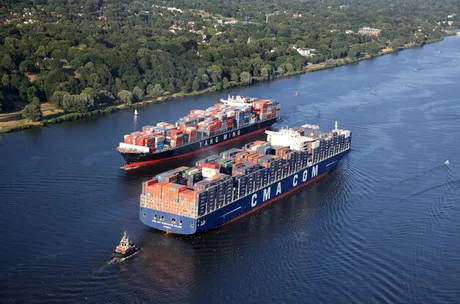Ahead of the G7 meeting at Biarritz from August 24-26, Rodolphe Saadé, Chairman and Chief Executive Officer of the CMA CGM Group, will announce two major decisions impacting the future of the maritime industry:
1. The CMA CGM fleet will not use the Northern Sea Route
2. The Group will give priority to liquefied natural gas to power its future ships

Photo: Port of Hamburg / Jochen Wischhusen
Protecting the Arctic, the world’s reservoir of biodiversity
Today, the Northern Sea Route, which runs the length of the Siberian Coast, connects Asia to Europe. It has been made navigable due to the effects of global warming. Rich in its unique and largely unexplored biodiversity, the Arctic plays an essential role in regulating ocean currents and global climate patterns. The use of the Northern Sea Route will represent a significant danger to the unique natural ecosystems of this part of the world, mainly due to the numerous threats posed by accidents, oil pollution or collisions with marine wildlife.
To avoid posing a greater threat to this fragile environment, Rodolphe Saadé has decided that none of the CMA CGM Group’s 500 vessels will use the Northern Sea Route along Siberia, which is now open due to climate change.
With this decision, CMA CGM makes the resolute choice to protect the environment and the planet’s biodiversity despite the major competitive advantage this route represents for shipping companies.
A pioneering Group in the use of liquefied natural gas to power ultra-large vessels
Today, liquefied natural gas offers the best proven solution available to significantly reduce the environmental footprint of maritime transport. The use of LNG reduces:
-emissions of sulphur and fine particles by 99%
-nitrogen oxides emissions by 85%
-carbon dioxide emissions by up to 20%
CMA CGM uses LNG power in its ultra-large ships that carry up to 23,000 containers. The first ship in this fleet of nine container vessels will be delivered as early as 2020. By 2022, the Group will have 20 LNG-powered vessels in its fleet.
CMA CGM continues its research into other energy sources and successfully tested a biofuel oil, made with 20% recycled vegetable oils and forest residues. It is also establishing research partnerships to develop hydrogen as a potential long-term energy solution.
CMA CGM, a leader in the energy transition of the shipping industry
During the meeting, Rodolphe Saadé will deliver to the President of France, on behalf of the maritime industry, the SAILS (Sustainable Actions for Innovative and Low-impact Shipping) Charter, formalized on the initiative of the Ministry for the Ecological and Inclusive Transition. Through this charter, the ten French signatory shipping companies, all members of Armateurs de France, commit to implementing specific actions in the reduction of emissions of air pollutants and greenhouse gases, whale protection, vessel energy optimization and performance, and strengthening of relations with the scientific community.
Between 2005 and 2015, CMA CGM has reduced its CO2 emissions per container transported by 50% and has a target to further reduce these emissions by a further 30% by 2025.
Source: hafen-hamburg.de
